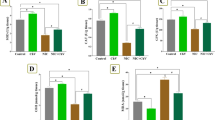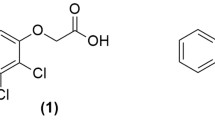Abstract
Piper betel leaves (PBL) are used in Chinese folk medicine for the treatment of various disorders. PBL has the biological capabilities of de-toxication, anti-oxidation and anti-mutation. In this study we first examined the effect of PBL extract on the activity of Glutathione S-transferase (GST) isoforms, and found that it inhibited total GST and the α class of GST (GSTA), but not the π class of GST (GSTP), and the μ class of GST (GSTM), activity in Hep G2 cells. RT-PCR results verified a reduction in the expression of GSTA1. Next, we examined whether PBL extract could increase the sensitivity of Hep G2 cells to anti-cancer drugs. The data showed that the cytotoxicity of cisplatin was significantly enhanced by the presence of PBL extract, accompanied by a reduction in the expression of multidrug resistance protein 2 (MRP2). These effects of PBL extract were compared to its major constitute, eugenol. Although eugenol decreased MRP2 level more effectively than PBL extract, it exhibited less sensitizing effect. In conclusion, we demonstrated that PBL extract was able to increase the sensitivity of Hep G2 cells to cisplatin via at least two mechanisms, reducing the expression of MRP2 and inhibiting the activity of total GST and the expression of GSTA. The data of this study support an application of PBL as an additive to reduce drug resistance.







Similar content being viewed by others
Abbreviations
- CDNB:
-
1-Chloro-2,4-dinitrobenzene
- GSH:
-
Glutathione
- GST:
-
Glutathione S-transferase
- MTT:
-
3-[4,5-dimethylthiazol-2-yl] 2,5-diphenyltetrazolium
- MRP2:
-
Multidrug resistance protein 2
- PBL:
-
Piper betel leaves
References
Allan JM, Wild CP, Rollinson S, Willett EV, Moorman AV, Dovey GJ, Roddam PL, Roman E, Cartwright RA, Morgan GJ (2001) Polymorphism in glutathione S-transferase P1 is associated with susceptibility to chemotherapy-induced leukemia. Proc Nat Acad Sci 98:11592–11597
Alley MC, Scudiero DA, Monks A, Hursey ML, Czerwinski MJ, Fine DL, Abbott BJ, Mayo JG, Shoemaker RH, Boyd MR (1988) Feasibility of drug screening with panels of human tumor cell lines using a microculture tetrazolium assay. Cancer Res 48:589–601
Amonkar AJ, Padma PR, Bhide SV (1989) Protection effect of hydroxychavicol, a phenolic component of betel leaf, against the tobacco-specific carcinogens. Mut Res 210:249–253
Arruda VR, Lima CS, Grignoli CR, Melo MB, Lorand-Metze I, Alberto FL, Saad ST, Costa FF (2001) Increased risk for acute myeloid leukaemia in individuals with glutathione S-transferase mu 1 (GSTM1) and theta 1 (GSTT1) gene defects. Eur J Haematol 66:383–388
Azuine MA, Amonkar AJ, Bhide SV (1991) Chemopreventive efficacy of betel leaf extract and its constituents on 7,12-dimethylbenz(a)anthracene induced carcinogenesis and their effect on drug detoxification system in mouse skin. Ind J Exp Biol 29:346–351
Azuine MA, Bhide SV (1992) Protective single/combined treatment with betel leaf and turmeric against methyl (acetoxymethyl) nitrosamine-induced hamster oral carcinogenesis. Int J Cancer 51:412–415
Batist G, Tulpule A, Sinha BK, Katki AG, Myers CE, Cowan KH (1986) Overexpression of a novel anionic glutathione transferase in multidrug-resistant human breast cancer cells. J Biol Chem 261:15544–15549
Calvert P, Yao KS, Hamilton TC, O’Dwyer PJ (1998) Clinical studies of reversal of drug resistance based on glutathione. Chem Biol Interact 111–112:213–224
Cheng X, Kigawa J, Minagawa Y, Kanamori Y, Itamochi H, Okada M, Terakawa N (1997) Glutathione S-transferase-pi expression and glutathione concentration in ovarian carcinoma before and after chemotherapy. Cancer 79:521–527
Chomczynski P, Sacchi N (1987) Single-step method of RNA isolation by acid guanidinium thiocyanate-phenol-chloroform extraction. Anal Biochem 162:156–159
Choudhary D, Kale RK (2002) Antioxidant and non-toxic properties of piper betle leaf extract: in vitro and in vivo studies. Phytother Res 16:461–466
Habig WH, Pabst MT, Jakoby WB (1974) Glutathione-S-transferases. The first enzymatic step in mercapturic acid formation. J Biol Chem 249:7130–7139
Harada S, Tachikawa H, Kawanishi Y (2001) Glutathione S-transferase M1 gene deletion may be associated with susceptibility to certain forms of schizophrenia. Biochem Biophys Res Commun 281:267–271
Hengstler JG, Böttger T, Tanner B, Dietrich B, Henrich M, Knapstein PG, Junginger T, Oesch F (1998) Resistance factors in colon cancer tissue and the adjacent normal colon tissue: glutathione S-transferases α and π, glutathione and aldehyde dehydrogenase. Cancer Lett 128:105–112
Inoue T, Ishida T, Sugio K, Maehara Y, Sugimachi K (1995) Glutathione S-transferase pi is a powerful indicator in chemotherapy of human lung squamous cell carcinoma. Respiration 62:223–227
Kauffmann HM, Keepler D, Kartenbeck J, Schrenk D (1997) Induction of cMrp/cMoat gene expression by cisplatin, 2-acetylaminofluorene, or cycloheximide in hepatocytes. Hepatology 26:980–985
Keppler D, Cui Y, Konig J, Leier I, Nies A (1999) Export pumps for anionic conjugates encoded by MRP genes. Adv Enzyme Regul 39:237–246
Kitahara A, Satoh K, Nishimura K, Ishikawa T, Ruike K, Sato K, Tsuda H, Ito N (1984) Changes in molecular forms of rat hepatic glutathione S-transferase during chemical hepatocarcinogenesis. Cancer Res 44:2698–2703
Ko YC, Huang YL, Lee CH, Chen MJ, Lin LM, Tsai CC (1995) Betel quid chewing, cigarette smoking and alcohol consumption related to oral cancer in Taiwan. J Oral Pathol Med 24:450–453
Kool M, Haas M, Scheffer GL, Scheffer RJ, Eijk MJT, Juijn JA, Bass F, Borst P (1997) Analysis of expression CMOAT (MRP2), MRP3, MRP4, and MRP5, homologs of the multidrug resistance-associated protein gene (MRP1), in human cancer cell lines. Cancer Res 57:3537–3547
Lear JT, Heagerty AHM, Smith A, Bowers B, Payne C, Smith CA, Jones PW, Gilford J, Yengi L, Alldersea J, Fryer AA, Strange RC (1996) Multiple cutaneous basal cell carcinomas: glutathione-S transferase (GSTM1, GSTT1) and cytochrome P-450 (CYP2D6, CYP1A1) polymorphisms influence tumour numbers and accrual. Carcinogenesis 17:1891–1896
Mannervik B (1985) The isozymes of glutathione transferase. Adv Enzymol Relat Areas Mol Biol 57:357–417
Meyer DJ, Beale D, Tan KH, Coles B, Ketterer B (1985) Glutathione transferase in primary rat hepatomas: the isolation of a form with GSH peroxidase activity. FEBS Lett 184:139–143
Mistry P, Kelland LR, Abel G, Sidhar S, Harrap KR (1991) The relationships between glutathione, glutathione S-transferase and cytotoxicity of platinum drugs and melphalan in eight human ovarian carcinoma cell lines. Br J Cancer 64:215–220
Morrow CS, Smitherman PK, Diah SK, Schneider E, Townsend AJ (1998) Coordinated action of glutathione S-transferases (GSTs) and multidrug resistance protein 1 (MRP1) in antineoplastic drug detoxification. J Biol Chem 273:20114–20120
Padma PR, Lalitha VS, Amonkar AJ, Bhide SV (1989) Anticarcinogenic effect of betel leaf extract against tobacco carcinogens. Cancer Lett 45:195–202
Rebbeck TR (1997) Molecular epidemiology of the human glutathione-S-transferase genotypes GSTM1 and GSTT1 in cancer susceptibility. Cancer Epidemiol Biomarkers Prev 6:733–743
Ren W, Qiao Z, Wang H, Zhu L, Zhang L (2003) Flavonoids: promising anticancer agents. Med Res Rev 23:519–534
Rompelberg CJ, Ploemen JH, Jespersen S, Greef J, Verhagen H, Bladeren PJ (1996) Inhibition of rat, mouse, and human glutathione S-transferase by eugenol and its oxidation products. Chem Biol Interact 99:85–97
Schrenk D, Baus PR, Ermel N, Klein C, Vorderstemann B, Kauffmann HM (2001) Up-regulation of transporters of the MRP family by drugs and toxins. Toxicol Lett 120:51–57
Smitherman PK, Townsend AJ, Kute TE, Morrow CS (2004) Role of multidrug resistance protein 2 (MRP2, ABCC2) in alkylating agent detoxification: MRP2 potentiates glutathione S-transferase A1-1-mediated resistance to chlorambucil cytotoxicity. J Pharmacol Exp Ther 308(1):260–267
Stoehlmacher J, Park DJ, Zhang W, Groshen S, Tsao-Wei DD, Yu MC, Lenz HJ (2002) Association between glutathione S-transferase P1, T1, and M1 genetic polymorphism and survival of patients with metastatic colorectal cancer. J Natl Cancer Inst 94(12):936–942
Strange RC, Spiteri MA, Ramachandran S, Fryer AA (2001) Glutathione-S-transferase family of enzymes. Mutat Res 482:21–26
Taniguchi K, Wada M, Kohno K, Nakamura T, Kawabe T, Kawakami M, Kagotani K, Okumura K, Akiyama S, Kuwano M (1996) A human canalicular multispecific organic anion transporter (cMOAT) gene is overexpressed in cisplatin-resistance human cancer cell lines with decreased drug accumulation. Cancer Res 56:4124–4129
Trivedi AH, Patel RK, Rawal UM, Adhvaryu SG, Balar DB (1994) Evaluation of chemopreventive effects of betel leaf on the genotoxicity of pan masala. Neoplasma 41:177–181
Vernhet L, Allain N, Le Vee M, Morel F, Guillouzo A, Fardel O (2003) Blockage of multidrug resistance-associated proteins potentiates the inhibitory effects of arsenic trioxide on CYP1A1 induction by polycyclic aromatic hydrocarbons. J Pharmacol Exp Ther 304(1):145–155
Yang Y, Cheng JZ, Singhal SS, Saini M, Pandya U, Awasthi S, Awasthi YC (2001) Role of Glutathione S-Transferases in Protection against Lipid Peroxidation. J Biol Chem 276:19220–19230
Zhang Y, Zuo GQ, Tang WX (2004) Study on apoptosis of human hepatoma cell line HepG2 induced by oxaliplatin. Zhonghua Gan Zang Bing Za Zhi 12(6):374–375
Acknowledgements
This work was supported by the grants from National Science Council (NSC92-2745-B-040-001) and Chung Shan Medical University (CSMC 90-OM-B-007), Taichung, Taiwan.
Author information
Authors and Affiliations
Corresponding author
Rights and permissions
About this article
Cite this article
Young, SC., Wang, CJ., Hsu, JD. et al. Increased sensitivity of Hep G2 cells toward the cytotoxicity of cisplatin by the treatment of piper betel leaf extract. Arch Toxicol 80, 319–327 (2006). https://doi.org/10.1007/s00204-005-0051-3
Received:
Accepted:
Published:
Issue Date:
DOI: https://doi.org/10.1007/s00204-005-0051-3




